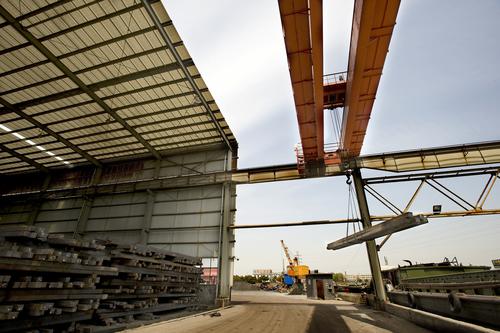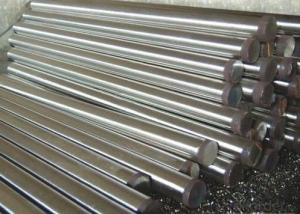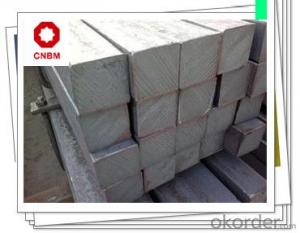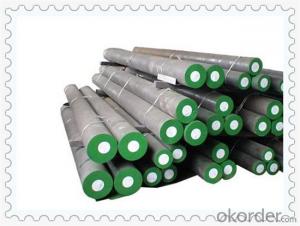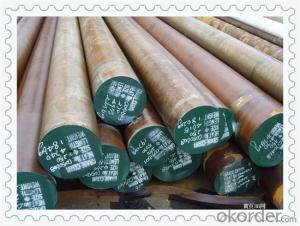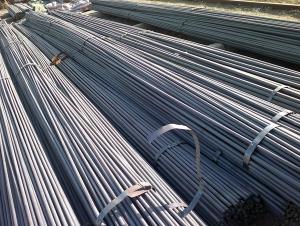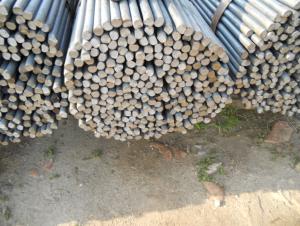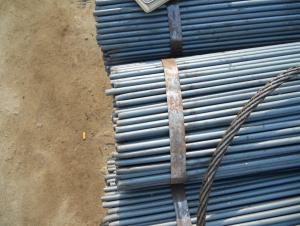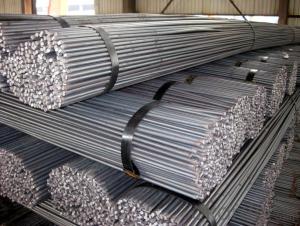steel carbon round bar
- Loading Port:
- China Main Port
- Payment Terms:
- TT or LC
- Min Order Qty:
- -
- Supply Capability:
- -
OKorder Service Pledge
OKorder Financial Service
You Might Also Like
Product Description:
OKorder is offering Round Bar at great prices with worldwide shipping. Our supplier is a world-class manufacturer of steel, with our products utilized the world over. OKorder annually supplies products to European, North American and Asian markets. We provide quotations within 24 hours of receiving an inquiry and guarantee competitive prices.
Product Applications:
1. Hot rolled round bar of 6-25mm, or small round is mostly used for straight bundles supply, and used for steel, bolts and various mechanical parts. While the bigger round bar, or more than 25mm hot rolled bar, is mainly for the manufacture of mechanical parts or for seamless steel billet.
2. Besides, we can supply some especial material steel round bar that can be used for main shaft of steamer, hummer shank, with big section and supper force.
Product Advantages:
OKorder's Round Bar are durable, strong, and resist corrosion.
Main Product Features:
· Premium quality
· Prompt delivery & seaworthy packing (30 days after receiving deposit)
· Corrosion resistance
· Can be recycled and reused
· Mill test certification
· Professional Service
· Competitive pricing
Product Specifications:
1. Grade: Q195, Q235, Q345
2. Diameter: 6mm-150mm
3. Length: 6m, 9m, 12m or as customer’s request
4. Tolerance: Within ±5% for weight; ±2mm for diameter
5. Note: The price can be better is the quantity is good
6. Chemical composition
Alloy No | Element (%) | ||||
C | Mn | S | P | Si | |
Q195 | 0.06-0.12 | 0.25 | ≤0.05 | ≤0.045 | ≤0.3 |
Q235 | 0.12—0.20 | 0.3—0.7 | ≤0.045 | ≤0.045 | ≤0.3 |
Q345 | ≤0.2 | 1.00-1.60 | ≤0.045 | ≤0.045 | ≤0.55 |
Packaging & Delivery of Round Bar
Packaging Detail: All goods are packed in bundle with steel strips and shipped by break bulk vessel or container (depend on target market and different ports)
Delivery Detail: 45 days
Trade terms: FOB, CFR, CIF
Quality Assurance of Round Bar
1. We will strictly inspect our production that we sold according to the customer’s request.
2. Quality should be in conformity with the specification of the manufacturer. Quantity and packing conditions should be in conformity with the term in the contract.
3. Should the packing found damaged, the buyer has the right to claim to the seller.
FAQ:
Q1: Why buy Materials & Equipment from OKorder.com?
A1: All products offered byOKorder.com are carefully selected from China's most reliable manufacturing enterprises. Through its ISO certifications, OKorder.com adheres to the highest standards and a commitment to supply chain safety and customer satisfaction.
Q2: How do we guarantee the quality of our products?
A2: We have established an advanced quality management system which conducts strict quality tests at every step, from raw materials to the final product. At the same time, we provide extensive follow-up service assurances as required.
Q3: How soon can we receive the product after purchase?
A3: Within three days of placing an order, we will begin production. The specific shipping date is dependent upon international and government factors, but is typically 7 to 10 workdays.
Q4: What makes stainless steel stainless?
A4: Stainless steel must contain at least 10.5 % chromium. It is this element that reacts with the oxygen in the air to form a complex chrome-oxide surface layer that is invisible but strong enough to prevent further oxygen from "staining" (rusting) the surface. Higher levels of chromium and the addition of other alloying elements such as nickel and molybdenum enhance this surface layer and improve the corrosion resistance of the stainless material.
Images:
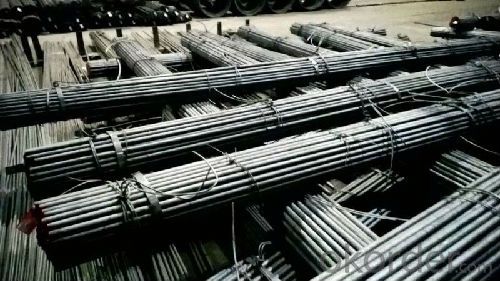

- Q: What is the difference between a hot rolled and a turned steel round bar?
- The main difference between a hot rolled and a turned steel round bar lies in the manufacturing process and the resulting characteristics of the finished product. A hot rolled steel round bar is produced by heating a billet or ingot of steel to a high temperature and then rolling it into the desired shape. This process allows for the steel to be formed and shaped easily, resulting in a bar with a rough surface and a slightly rounded or irregular shape. Hot rolling also helps to improve the overall strength and toughness of the steel, making it suitable for a wide range of applications. On the other hand, a turned steel round bar is produced by machining a hot rolled or cold drawn bar on a lathe. This process involves removing material from the surface of the bar using cutting tools, resulting in a smooth and precise finish. Turning also allows for greater dimensional accuracy and control over the final shape and size of the bar. In terms of surface finish and dimensional accuracy, a turned steel round bar generally offers a higher level of precision compared to a hot rolled bar. The turned bar has a smoother surface with fewer imperfections, making it ideal for applications where appearance and aesthetics are important. Additionally, the turned bar typically has tighter tolerances, ensuring consistent dimensions throughout its length. The choice between a hot rolled and a turned steel round bar depends on the specific requirements of the application. Hot rolled bars are commonly used in construction, manufacturing, and general engineering applications where strength and toughness are crucial. Turned bars, on the other hand, are often used in industries such as automotive, aerospace, and precision machining, where a high level of surface finish and dimensional accuracy is required. In summary, the difference between a hot rolled and a turned steel round bar lies in the manufacturing process and the resulting characteristics. Hot rolled bars offer strength and toughness, while turned bars provide a smoother surface finish and greater dimensional accuracy. The choice depends on the specific needs of the application.
- Q: On the market, 8mm Round Bar is not 9 meters a root? How much does it weigh about 300 meters? How much does it cost?
- The weight is 0.395 kilograms / meter by the theory. Can be rolled, is not the foot, the largest is 7.5 diameter, the price depends on the place, and the price is different from place to place
- Q: What are the advantages of using nickel-chromium-titanium alloy steel round bars?
- Some advantages of using nickel-chromium-titanium alloy steel round bars include their high strength and durability, excellent corrosion resistance, and good heat resistance. These alloy steel round bars also offer superior wear resistance and can withstand harsh environments. Additionally, they have good machinability, making them suitable for various applications in industries such as aerospace, automotive, and oil and gas.
- Q: Can steel round bars be used in the automotive parts industry?
- Yes, steel round bars can be used in the automotive parts industry. Steel round bars are commonly used in the manufacturing of various automotive components due to their excellent strength, durability, and resistance to wear and tear. These bars can be fabricated into different shapes and sizes to meet the specific requirements of automotive parts such as axles, drive shafts, suspension components, steering components, and gears. The use of steel round bars ensures the structural integrity and reliability of automotive parts, making them ideal for withstanding the demanding conditions and loads experienced in the automotive industry.
- Q: Can steel round bars be hardened or tempered?
- Yes, steel round bars can be hardened or tempered.
- Q: What are the different surface defects that can occur in steel round bars?
- There are several different surface defects that can occur in steel round bars. These defects can be classified into various categories based on their appearance and severity. Some of the common surface defects include: 1. Scale: Scale is a thin layer of oxide that forms on the surface of steel during the manufacturing process. It appears as a rough, flaky coating and can be easily removed by mechanical means. 2. Pits: Pits are small depressions or craters that can occur on the surface of the steel. They are usually caused by corrosion or mechanical damage. Pits can weaken the structural integrity of the steel and may require repair or replacement. 3. Scratches: Scratches are shallow grooves or cuts on the surface of the steel. They can be caused by handling, transportation, or machining processes. While minor scratches may not affect the performance of the steel, deep scratches can lead to stress concentration and potential failure. 4. Roll marks: Roll marks are raised or depressed lines or patterns that are left on the surface of the steel during the rolling process. These marks are typically caused by the uneven pressure distribution between the rolls and can affect the dimensional accuracy and surface quality of the steel. 5. Laminations: Laminations are thin layers or bands of non-metallic inclusions that can occur parallel to the surface of the steel. They are usually caused by inadequate refining or improper casting techniques. Laminations can decrease the strength and toughness of the steel and may require further processing or rejection. 6. Decarburization: Decarburization refers to the loss of carbon content on the surface of the steel. It can occur during heating, annealing, or hot working processes. Decarburization can reduce the hardness and strength of the steel and may lead to premature failure under load. 7. Surface cracks: Surface cracks are visible cracks that occur on the surface of the steel. They can be caused by excessive cooling rates, improper heat treatment, or mechanical stress. Surface cracks can compromise the structural integrity of the steel and may require repairs or rejection. These are just a few examples of the different surface defects that can occur in steel round bars. It is essential to inspect and address these defects to ensure the quality and performance of the steel in various applications.
- Q: Are steel round bars available in custom sizes?
- Yes, steel round bars are available in custom sizes. Steel round bars can be manufactured to meet specific size requirements and specifications. Custom sizes can be requested based on the diameter, length, and overall dimensions of the round bar. Whether it is for a specific project or application, many steel manufacturers and suppliers offer the option to customize the size of round bars to suit individual needs.
- Q: How are steel round bars used in the manufacturing of machinery and equipment?
- Due to their inherent strength, durability, and versatility, steel round bars find extensive use in the production of machinery and equipment. These bars, typically made from carbon steel or alloy steel, are available in various diameters and lengths. One of the common applications of steel round bars is in fabricating shafts and axles, which are crucial for transmitting rotational motion and torque in machinery. These bars offer the necessary strength and stiffness to withstand the forces and stresses experienced during operation. They are often machined precisely and subsequently heat-treated to enhance their mechanical properties, such as hardness and toughness. Another significant use of steel round bars is in the manufacture of gears and sprockets. These components are essential for transmitting power and motion between different machine parts. Steel round bars are machined to form teeth or cogs that interlock, ensuring smooth and efficient operation. The high strength and wear resistance of steel enable gears and sprockets to endure heavy loads and repetitive motion without distorting or failing. Steel round bars also find application in manufacturing various machine components like bearings, couplings, and fasteners. Bearings, for example, depend on the strength and hardness of steel to support rotating or sliding shafts while minimizing friction and wear. Couplings, on the other hand, utilize steel round bars to connect different machine parts, efficiently transmitting power and motion. Steel round bars also serve as fasteners, providing a secure and dependable connection between different machine elements. Furthermore, steel round bars are frequently used in constructing machine frames and structures. Their high strength-to-weight ratio makes them ideal for providing structural support and stability. By utilizing steel round bars, manufacturers can create robust and reliable machinery and equipment capable of withstanding heavy loads, vibrations, and other challenging operating conditions. In conclusion, steel round bars play a vital role in the manufacturing of machinery and equipment. Their exceptional strength, durability, and versatility make them a favored choice for a wide range of applications. Whether it is for shafts, gears, bearings, or machine frames, steel round bars provide the necessary mechanical properties to ensure the reliable and efficient operation of machinery and equipment.
- Q: What are the different types of steel round bars used in the manufacturing of tools?
- In tool manufacturing, a variety of steel round bars are commonly employed. Each type of steel possesses distinct properties and qualities that make it suitable for various applications. The following are some of the most frequently utilized steel round bars in tool manufacturing: 1. Carbon Steel Round Bars: These round bars are widely used in tool manufacturing due to their exceptional strength and durability, making them ideal for heavy-duty applications. Carbon steel round bars can be further categorized into low carbon, medium carbon, and high carbon steel, based on their carbon content. 2. Alloy Steel Round Bars: Alloy steel round bars are created by incorporating diverse alloying elements, such as manganese, chromium, nickel, or molybdenum, into carbon steel. This process enhances their strength, hardness, and resistance to wear and tear. Cutting tools, drills, and gears are commonly manufactured using alloy steel round bars. 3. Stainless Steel Round Bars: Stainless steel round bars are renowned for their resistance to corrosion and high tensile strength. They are frequently employed in the production of tools that require protection against rust, such as kitchen knives, surgical instruments, and automotive components. 4. Tool Steel Round Bars: Tool steel round bars are specifically designed for tool manufacturing, as the name suggests. They possess high hardness, wear resistance, and toughness, making them ideal for cutting, drilling, and shaping applications. Tool steel round bars can be further classified into various types, including high-speed steel (HSS), cold work steel, hot work steel, and shock-resistant steel, based on their specific properties. 5. Stainless Tool Steel Round Bars: Stainless tool steel round bars combine the qualities of stainless steel and tool steel. They offer good resistance to corrosion and wear, making them suitable for applications that require both properties, such as the production of molds and dies. These examples represent just a few of the diverse types of steel round bars employed in tool manufacturing. The choice of steel depends on the specific requirements of the tool and its intended application.
Send your message to us
steel carbon round bar
- Loading Port:
- China Main Port
- Payment Terms:
- TT or LC
- Min Order Qty:
- -
- Supply Capability:
- -
OKorder Service Pledge
OKorder Financial Service
Similar products
Hot products
Hot Searches
Related keywords



